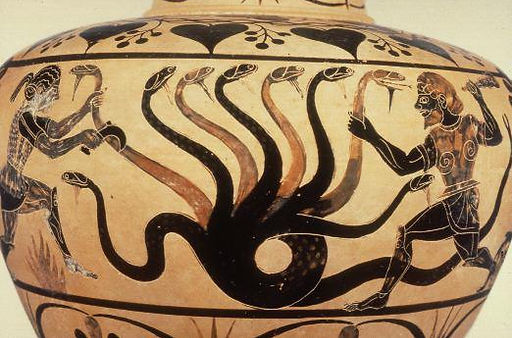HYDRA
The multi-headed monster
The Hydra, or the Lernaean Hydra, is a multi-headed serpentine monster that inherited its snake-like features from the mother, Echidna. The monster received its multiple heads from the father, Typhoeus. The monster was equipped with "eight mortal heads, and a ninth one in the middle that was immortal" (Aldrich 77-80). Hydra’s many heads was inherited from the father, Typhon (Clay 110). The Hydra resembles Cerberus and the Chimera due to the polycephaly they all exhibit, although they all remain morphologically diverse. Oddly enough, the Chimera may be the daughter of the Hydra rather than its sibling (Clay 113).
The Lernaean Hydra received its name due to the fact that it resides in lake Lerna in the Peloponnese, in the southern region of Greece. The Hydra was said to guard a path to the underworld within the Lernaean swamps (Quartermain). Hesiod describes the Hydra as "insatiably wrathful" in its fight against Hercules (line 315). This monster was extremely difficult to kill with an average weapon due to the fact that it immediately produced two more heads after one was cut off. In addition to its regenerative abilities, the Hydra was difficult to kill because it received aid from a giant crab that shared its waters. Specifically, this giant crab bit Hercules on the foot (West 461).
The Hydra was uniquely able to reside on Earth, into the “inhabited world,” (Clay 111) therefore posing a large threat to those who came in contact with it. This was unlike the monsters who came before it who were “confined either under the earth or located at its extreme boundaries,” (Clay 110) and those who sought to destroy them were required to travel great distances.
The idea of a many headed monster wan't unique to the ancient Greeks. References to a many-headed beast such as the Hydra were also found in Canaanite mythology (Lôtān) and the biblical Leviathan (West 461). The crab-serpent alliance was also referenced in Mesopotamian seals.

The vase (right) dating back to 600 BC depicts the battle between the Lernaean Hydra and Heracles. The Hydra was raised by the Greek goddess Hera, Zeus' wife, and she intended to use the monster to kill Heracles. Heracles traveled to Lerna on a chariot to defeat the monster, along with "Ioloas, Heracles' nephew and sidekick" (Strauss 111). When Heracles arrived at the swamps of Lerna, he covered his face to protect from the Hydra's poisonous breath, for "if anyone passed by when she was sleeping, he breathed her tracks and died in greatest torment." (Pseudo-Hyginus, Fabulae 30) When faced with the Hydra, he began to decapitate the heads of the large creature, only to find that more immediately grew in its place. Heracles "commanded Iolaos to sear with a burning brand the part which had been severed," (Diodorus Siculus) which proved to be successful in stopping the Hydra from producing more heads, allowing Heracles the ability to subdue the monster and eventually kill it.
The Slaying of the Hydra

Hercules and the Hydra Lernaean by Gustave Moreau (1876)
Heracles & the Hydra, Paestan black-figure hydra
C6th B.C., J. Paul Getty Museum, Malibu

Fun Fact
The Hydra is featured in the 1997 Disney film Hercules, where it depicts the intense battle between Hercules (or Heracles) and the multi-headed beast.